
Making a killing with poisoned food
The ongoing drought conditions affecting many parts of the country is taking a deadly toll of animals and inland fish.
Wildlife officials from drought-stricken areas reported hunters had taken to poisoning natural waterholes where animals and birds regularly quench their thirst at Suriyawewa, Weliwewa and in 14 tanks found in Hambantota. This has already led to the death of a deer and seven goats in the vicinity of the waterholes.Unfortunately actions of unscrupulous persons attempting to make a fast buck via this sad situation are posing much danger to both man and beast.
What is worse is the flesh is being sold to villagers, despite the health risks involved.
Last week at the Kalawewa tank in Anuradhapura a haul of dead fish was discovered. The reason behind their death still remains a mystery and a foul odour prevailed in the area as a result of the putrefying fish.
However villagers are reportedly collecting the dead fish floating on the surface, for consumption. The product is also sold in the open market, despite the health risks.
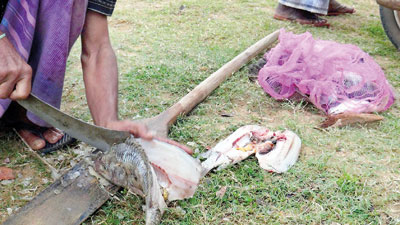
An unscrupulous man cuts up a dead fish which will soon be put on sale
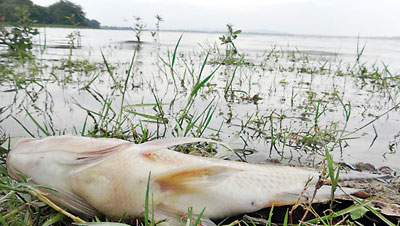
Unscrupulous traders may land this large dead fish which was washed ashore in your cooking pot or mine

Beware, hunters have taken to poisoning animals whose flesh they later sell to unsuspecting buyers
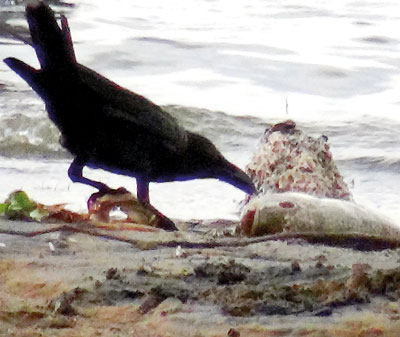
A crow attacking a tasty morsel
Source – 20/08/2017, The Sunday times, See more at – http://www.sundaytimes.lk/170820/news/making-a-killing-with-poisoned-food-255438.html

Fishing boats in the regulatory net for plastic waste
Thousands of fishing vessels that carry plastic water bottles and containers will be required to bring them back to shore under new laws being pondered to cut down the plastic waste piles that litter the oceans around Sri Lanka and choke precious marine life.
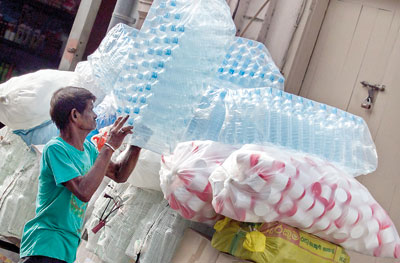
Sri Lanka among top marine polluters
When fishing vessels return to port, crews will be required to account for plastic containers they took on board. There are an estimated 53,900 fishing vessels in the dozen main fishing districts. The industry will be encouraged to use larger — five litres or more — water containers.
The Ministry of Fisheries and Aquatic Resources has joined hands with Marine Environment Protection Authority to bring in these measures.
Director General Christie Fernando said that all fishing vessels will have to account for the number of bottles of water. Boats will only be allowed to have on board containers of five-litre capacity or more and each vessel will be asked to report the number of bottles they have and account for the same on their return.
Fernando said that about 4,000 multi-day vessels cary about 100,00 litres of water to last a month. “They use the water for washing, cleaning, cooking purposes.’’
Fernando said a circular has been sent to all the district fisheries offices and to assistant fisheries directors. The regulation is being drafted and will be incorporated in the act soon, he said.
The Marine Environment Protection Authority said 22 fishing harbours will be monitored together with the Fisheries Ministry.
Chairman Rohana Perera said awareness of plastic waste will be raised. “We are encouraging them to manage, minimise and re-use plastic responsibly.’’
Source – 20/08/2017, The Sunday Times, See more at – http://www.sundaytimes.lk/170820/news/fishing-boats-in-the-regulatory-net-for-plastic-waste-255471.html

Desperate national parks battle poachers, curtail safaris and campers
National wildlife parks are struggling with an increase in poaching and are limiting access to safari operators and campers amid a devastating drought.
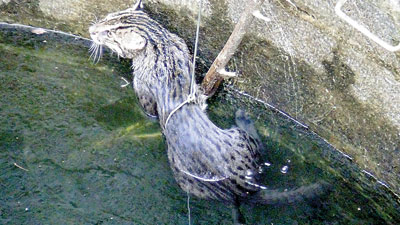 A fishing cat (handun diviya) was rescued last morning when the desperate animal in search of water had fallen into a well in Digampathana, Dambulla . Pic by K. Kanchana Kumara Ariyadasa
A fishing cat (handun diviya) was rescued last morning when the desperate animal in search of water had fallen into a well in Digampathana, Dambulla . Pic by K. Kanchana Kumara AriyadasaThe Yala National Park may even be closed to visitors next month.
There have been reports of animals poisoned at watering holes by poachers at various national parks.
Despite the drought, wildlife officials also say they will provide water only if necessary and instead allow nature to take its course.
Safari jeep operators are complaining of restrictions imposed on them.
The director general of the Department of wildlife Conservation, M G C Sooriyabandara said, park wardens are given the discretion to manage the situation and reduce safari vehicles entering the parks. “Even a one way system has been devised to reduce the same vehicles running up and down,” he said.
He said that the Yala National Park will be closed in September.
Mr Sooriybandara said that officials will rarely intervene in nature and will provide water only if it necessary.
“When we provide water, we choose tanks and watering holes near the safari trails regularly visited by tourists to attract animals, and to make sure that the regularly monitored area is secure from poachers.’’
He said joint patrols are undertaken against wildlife poachers. Wildlife range offices near national parks provide two officials from each office to combine with park rangers and form teams of 10 to carry out raids.
Meanwhile, park rangers and wardens have prepared their own plans.
The warden of the Wilpattu National Park, Chamath Lakshman Perera, said only 30 safari jeeps are allowed at a time, between 6:00 am and 10:00 and then from 2 p.m. to 6 p.m.Mr Perera added that both bungalows and campsites have been closed.
He said 28 small water tanks are being filled up using tanker trucks.
“Lots of poaching activities are happening during the dry months, so we reduce the safari jeeps,’’ he said.
Recently, they detected 13 trap guns and captured four armed men.
A wildlife official said the Yala National Park will be closed next month and will be re-opened after October.
Buddika Widanage, warden at Gal Oya National Park, said it was not badly affected by the drought thanks to the Senanayaka Samudraya. But he said the water levels in the reservoir had dropped.
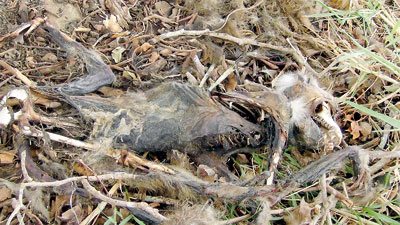
Thabbowa sanctuary: Fast turning into a graveyard for wild animals. Pic by Hiran Priyankara
He said park rangers and officials of the nearby wildlife offices carry out night patrols to catch poachers who set up trap guns or leave poisoned food at watering holes.
Mr Widanage also said campers are only allowed if they bring their own water.
“Even the three-hour boat rides have been cut to two hours” he said.
The Minneriya Park has suffered from the drought since last year, warden Bhathiya Madugalle said. Elephants are the worst effected — less than 10 remain in the park. Animals have moved to Kandalama Park and Ritigala Eco Park.
Mr Mudalige said that there is also less elephant grass.
He explained that water and food are not provided to animals so that the natural balance is maintained and to allow for the survival of the fittest.
Meanwhile, the Independent Safari Jeep Drivers Association claims unfair treatment.
The head of the group, P D Keerthi, said most parks had reduced access. He claimed the operators could provide water and food for anim,als but wildlife officials and the minister would not allow it.
Mr Keerthi also said the one way drive system for safari jeeps could be dangerous in the event of an attack by elephants, when reversing is the only choice.
He complained that although they are regulated, VIPs are allowed roam in the parks day and night.
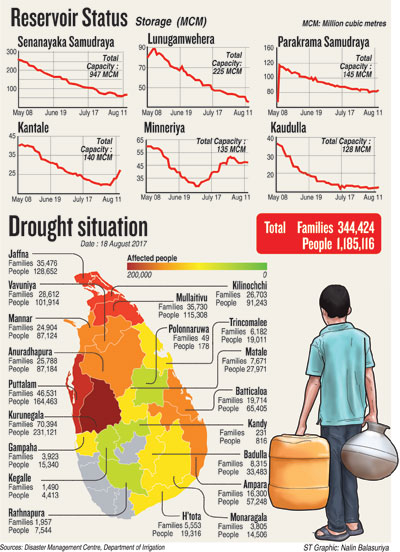
Source – 20/08/2017, The Sunday Times See more at – http://www.sundaytimes.lk/170820/news/desperate-national-parks-battle-poachers-curtail-safaris-and-campers-255478.html

The ‘Glen Falls’ at Nuwara Eliya is no more
The ‘Glen Falls’ which added much scenic beauty to Nuwara Eliya is drying up. The waterfall once synonymous with the town of Nu wara Eliya of which many a hotel and roads are named after is now visible only on rainy days. Area residents have watched as the waterfall dried up before their eyes.
wara Eliya of which many a hotel and roads are named after is now visible only on rainy days. Area residents have watched as the waterfall dried up before their eyes.
Colonial Governor Edward Barnes who designed and developed the town of Nuwara Eliya, set up his official residence in the vicinity of the magnificent 60 -70 metre high falls.
Today this beautiful waterfall is no more.
Despite the waterfall reappearing mainly during the monsoon season, this unfolding disaster does not seem to have attracted the attention of either the populace or those in positions of trust and authority.
Environmentalists claim the over utilisation of this precious water resource for the fast expanding commercial purposes as well as public sanitation, paved the way for the drying up of this once beautiful landmark.
They add potato cultivation on hill tops which commenced in the sixties also contributed to the drying up of the falls whose source spring is situated close to Shanthipura Kala Oya on the ‘Single Tree Mountain Range’ around 6,830 ft above sea level.
The then town of Nuwara Eliya 12.43 sq km in extent, was carved out by the British in 1828 and was originally a town of farmers with one Samuel Baker opening a 1,000-acre farm in 1848.
According to the census of 1881 ordered by then Government Agent (GA) Baros, the town was home to a population of 1,701 persons comprising 270 families.
Today the population consists of 35,000 persons, comprises around 7,500 houses, 3530 commercial buildings and 803 government buildings.
During the dry season water to the city is severely restricted as the sources for drinking water and sanitation needs remain the same as in 1881, other than the few deep-water wells provided via Japan’s JAICA.
The spurt in hotel construction will further stretch the scarce water resources in the area and will undoubtedly aggravate the situation.
If the situation is not tackled with sensitivity even the future existence of the city of Nuwara Eliya remains at risk.

Source – 20/08/2017,The Sunday Times, See more at – http://www.sundaytimes.lk/170820/news/the-glen-falls-at-nuwara-eliya-is-no-more-255450.html

See the agony of this monkey, but what do we do?
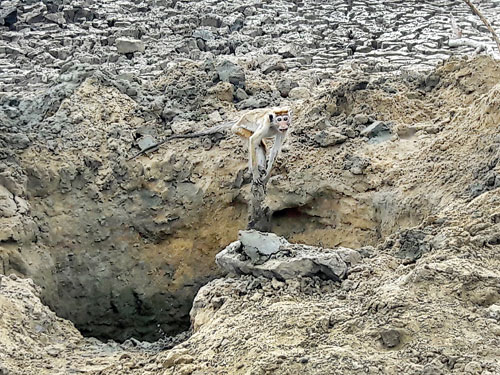
A skeletal monkey with little but skin and bone is seen after it quenched its thirst and struggled out of a temporary well that compassionate people had dug with a cloth ladder for the voiceless and helpless creatures in the fire and fury of the ongoing drought. The temporary well was dug at the Meegaswewa tank in the Thabbowa Park in the Puttalam District. Reports say hundreds of monkeys and other animals have died after suffering for weeks and months in the barren waste. Pic by Karuwalagaswewa Jayaratne.
Source – 20/08/2017, The Sunday Times, See more at – http://www.sundaytimes.lk/170820/news/see-the-agony-of-this-monkey-but-what-do-we-do-255590.html

Death of seven-feet leopard being probed
The Wild Life Conservation Department is probing the death of a seven-feet male leopard in the Deltota, Lulakanda area.
Assistant Forest Range officer G R Dharmarathna told the Daily Mirror that the leopard was found dead on Monday evening following information provided by resident to the area wild life office.
An official from the Wild Life Conservation Department said the carcass of the leopard was handed over to the Peradeniya veterinary surgeon for a postmortem.
He said the reason for the leopard’s death had not been established so far.
The Sri Lankan leopard is a subspecies of leopards native to Sri Lanka that was first described in 1956 by the Sri Lankan zoologist Deraniyagala.
The leopard was listed as an Endangered species on the International Union for Conservation of Nature (IUCN) Red List in 2008 is also an offense to kill, trade or harm a leopard under the Wildlife Act.
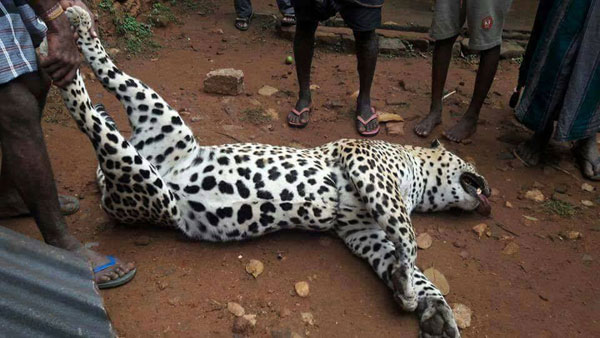
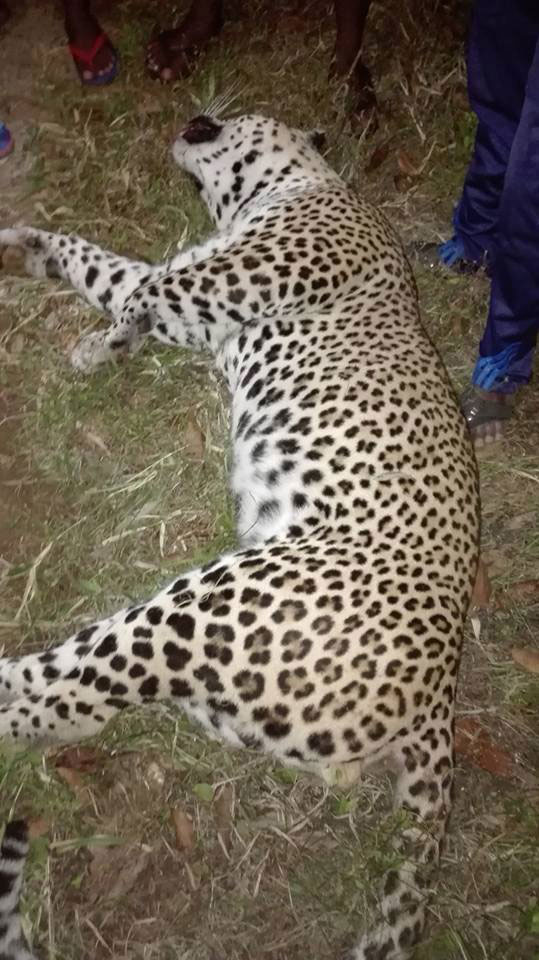
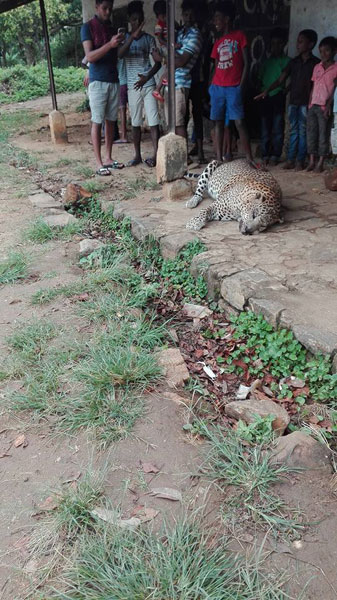
Source – DailyMirror, See more at – http://www.dailymirror.lk/134995/Death-of-seven-feet-leopard-being-probed



